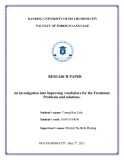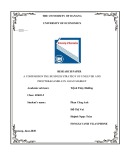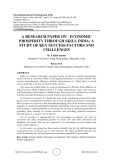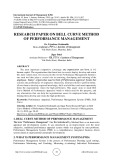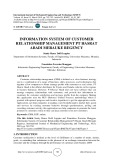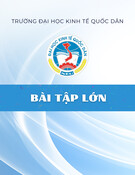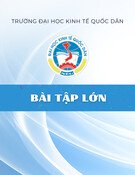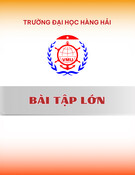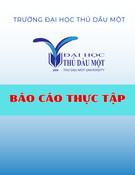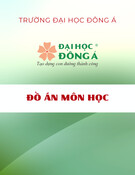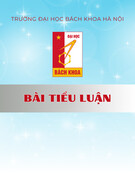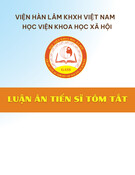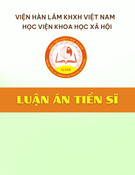THE UNIVERSITY OF DANANG
UNIVERSITY OF ECONOMICS
RESEARCH PAPER
A COMPARISON THE BUSINESS STRATEGY OF UNILEVER AND
PROCTER&GAMBLE IN ASIAN MARKET
ườ ị Academic advisors: Tr nh Thúy H ng
Class: 42K01.5
Student’s name: Phan Công Anh
ồ ị H Th Vui
ọ ỳ Hu nh Ng c Toàn
FONGSAVANH VILAYPHONE
Danang, June,2020
LIST OF PICTURE
INTRODUCTION
1. Rationale
Nowadays, as globalization is becoming popular and necessary for every country in the
world, multinational companies are also formed quickly with the desire to reach out to the
international market, creating an increase. growth in size and sales. Growth is
indispensable to maintain for each company, so choosing the strategy to reach out to the
international market plays an extremely important role for each company. The right
strategy not only helps the company gain profits in the short term but also paves the way
for longterm development.
Markets around the world are different in culture, economy, income level, demographics,
etc. Understanding different strategies of different companies has become an
indispensable experience for each company.
In the world, two famous corporations in the field of consumer goods, Unilever and P&G,
are typical for approaching the market with different strategies that bring different
advantages, especially in Asian markets. .
2. Objects and scope of research
The scope of the study is the operation of Unilever and P&G in typical countries in Asia
such as Japan, Vietnam, Singapore, ... The research period is conducted from the time
2
when companies penetrate the market and the main ones. The book has changed to adapt
to that market.
3. Methodology
The paper is studied by methods of data collection and data analysis.
4. Layout of the thesis
The paper consists of 4 chapters:
Chapter 1: Theoritical basic
Chapter 2: UNILEVER'S ASIAN MARKET STRATEGY
Chapter 3: P&G'S BUSINESS STRATEGY IN ASIAN MARKETS
Chapter 4: COMPARE STRATEGY OF P&G AND UNILEVER
3
Chapter 1
THEORETICAL BASIS
1.1 Multinational company
Multinational companies are often referred to as MNC (multinational corporation) or
MNE (multinational enterprise), which refers to companies producing or providing
services in two countries, which can greatly influence relationships. international relations
when they have a major economic impact on some areas with abundant financial
resources, serving public relations and political corridors. Multinational companies
operate and are based in many different countries.
Multinational companies play an important role in the process of globalization, a new
form of MNE is formed corresponding to the process of globalization it is a global
consortium enterprise.
1.2 Characteristics of multinational companies
Centralized ownership: affiliates, subsidiaries, and agents around the world are owned by
the parent company, even though they have specific daily activities that are not exactly
the same.
1.3 The purpose of development of multinational companies
First, there is the need to internationalize manufacturing and markets to avoid trade
restrictions, quotas, import duties in countries of purchase, use of raw materials, cheap
labor, and exploitation of local potential. Second, it is the need to use the competitiveness
and comparative advantages of the host country, making the transfer of hightech
industries.
Third, seek higher profits and risk dispersion. As well as avoiding the instability caused
by the business cycle when manufacturing in a single country In addition, protecting the
monopoly of technology or production knowhow in an industry that does not want to be
transferred is also a reason to expand the locality for production. Besides, cost
optimization and market expansion are also the goals of MNC. The operation of MNCs,
because it is carried out in an international environment, issues such as input markets,
output markets, transportation and distribution, capital mobilization, payment ... have
certain risks. The common risks of MNCs fall into the following two groups: Risks in
buying and selling goods such as: tariffs, transportation, insurance, supplydemand cycles,
other macro policies ... Risks in transition finance such as risks when local government
policies change, risks of exchange rates, inflation, foreign exchange management policies,
taxes, debt crisis ...
1.4 International business strategies of multinational companies
1.4.1 The International Strategy
The product is manufactured in the domestic market and sold to other countries with
minimum adjustments according to local requirements. Each Strategic Business Unit has
the right to actively apply this strategy. This strategy is less under pressure to reduce costs
and the pressure of local requirements (because production is primarily localized). But it
is highly sensitive to exchange rate and political risks
Features of the international strategy:
(cid:0) Exploiting comparative advantage, domestic position to turn into a competitive
advantage
(cid:0) Entering into skillsdeficient markets of MNC. Value is created by moving the
core of competition from the country to abroad, where competitors are not able
to develop, respond, and maintain in a similar fashion when expanding markets.
foreign school
(cid:0) Centralizing product development functions such as R&D in the country,
producing products according to domestic market demand standards.
(cid:0) Establish production and marketing divisions in key regions and countries
where they do international business
(cid:0) Headquarters headquarters strictly control marketing strategies and products,
local adaptation is limited.
(cid:0) International activities ranked second after the market in the country
Limitations:
(cid:0) May miss opportunities in local market.
(cid:0) Not specifically grasping the needs of other localities.
(cid:0) Not a longterm strategy
1.4.2 The Transnational Strategy
The strategy that MNC seeks to achieve global efficiency and respond locally, sharing the
common mission of MNC but taking action that varies according to local requirements
(standardizing where possible, adapting where required) Selecting an optimal location
cannot guarantee that the quality and cost of the inputs there will also be optimal. Transfer
of experience can be a core resource of competitive advantage, but experience cannot be
transferred automatically.
Features of the Transnational strategy:
(cid:0) Competitive advantage can be developed in any of MNC's operating units
(cid:0) Try to achieve low cost based on regional economy, economies of scale, effective
learning as well as production differentiated products for customers in different
areas, encourage opening up in places where developing operational skills in
global operations
(cid:0) The product and skills line can be transferred between units in MNC, collective
promote the development of skills in global learning institutions
(cid:0) The value created by innovation reinforces and exchanges ideas, products and
processes
Limitation: Implementing this strategy has many difficulties. because local response
increases cos
Two trends need to be avoided: focus the company's operations too large on a central
location, or because it wants to increase the level of local adaptability that distributes the
company's operations across too many different locations.
1.4.3 The Global Strategy
MNC expands overseas markets based on standardization and competitive costs; Value is
created based on product design for the global market and the most effective production
and marketing. The scale of production and distribution of products has been improved,
facilitating development investment and reducing costs very positively; but difficult to
meet local needs.
Features:
(cid:0) Link SBU in many countries to share cheap resources, emphasizing the issue of
ensuring the size of economic benefits.
(cid:0) Standardize global products to maximize profits by exploiting scale, regional
economic learning (strategic location)
(cid:0) Not trying to meet local Suitable for industrial products
(cid:0) Strategic objectives The strategy is to pursue a global lowcost strategy to support
the "aggressive pricing" in the world. some of the most favorable positions on the
global scale (outsource)
(cid:0) Decentralized decision at headquarters
Limited: inappropriate in markets that need high adaptation
1.4.4 The multidomestic Strategy
Strategic decisions and activities disaggregated by business unit of each country. This
strategy has a high customer base but limits the exploitation of economic scale, learning
and coordinating information.
Features of the Mutildomestic Strategy:
(cid:0) Focusing on competition in each market
(cid:0) Make a profit by offering customers a product that meets the tastes of different
national markets, resulting in increased product value in the local national market
and pushing up product prices
(cid:0) High local decentralization (proximity to location and culture)
(cid:0) Value created by empowering local administrators to adapt to local economic and
legal economic environment
(cid:0) Suitable when available many branches in countries and the pressure to reduce
costs is not large Suitable for consumer products
Limitations: high costs
Chapter 2
UNILEVER'S ASIAN MARKET STRATEGY
2.1 General introduction about Unilever
2.1.1 General infomation
Unilever is a global corporation founded in the 1930s of England and the Netherlands that
is worldrenowned in the field of manufacturing and fastmoving consumer products
including home and personal hygiene products, eat, tea and tea drinks. Typical Unilever
brands are widely consumed and accepted globally such as Lipton, Knorr, Cornetto, Omo,
Lux, Vim, Lifebouy, Dove, CloseUp, Sunsilk, Clear, Pond's, Hazeline, Vaseline, ... with
sales of over millions of dollars for each brand has proved Unilever is one of the most
successful companies in the world in the field of consumer healthcare business (Personel
Care) .. Along with Proctol & Gambel (P&G), Unilever currently dominate the world on
these products.
Some basic information of Unilever
Founded: Merged Lever Brothers and Margarine Unie in 1930
Headquarters: London and Rotterdam
Industry: Manufacturing (Household Appliance, Food, Personal Care)
Type: Mass
Key employees: Paul Polman (CEO), Marijn Dekkers (chairman)
Website: www.unilever.com
2.1.2 History of formation
10
Unilever was founded with the original name of Lever Brothers, starting its soap business.
The initiator of the initial business idea was Wiliam Hesketh Lever. In 1884, he bought
himself a small soap factory. He then focused on marketing his products, thereby
increasing production by 20 to 450 tons per week. At that time, his workshop had two
strategic products: Lever’s pure Honey and Sunlight. By March 1888, he decided to
expand the factory to an area of over 23 hectares. In 1890, Lever decided to expand the
market beyond Britain's borders with the first overseas markets being Australia, Canada,
Germany, and Switzerland. In 1906, the company acquired Vinolia, a soapmaking
company. In 1910, the Company acquired Hudson’s a major detergent manufacturer in
the UK. From 19101915, Lever bought three more British soapmaking companies, one
of which was Pears, one of Unilever's rivals.
By 1911, the Lever brothers had a huge market share, and one out of every three soap bars
was Lever.
After World War I, the company continued to expand into Africa.
Until January 1930, a merger of Margarine onion (Netherlands) and Lever Brothers
(England) created an AngloDutch alliance with the new name Unilever.
To avoid double taxation of the two countries, the company has split into Unilever PCl
based in the UK and Unilever NV based in the Netherlands.
2.1.3 Mission, vision, business goals
2.1.3.1 Mission
Activity to create a fresher future every day. Unilever's mission is to make everyone feel
comfortable, improve their beauty and get rid of life's worries with products that are good
for them and those around them. And they achieve this by creating and producing
products that are affordable, suitable for all walks of life and society around the world.
11
Inspire people through daily actions through our products to make a big difference to the
world. Grow your company with a great caliber but still care about the surrounding
environment.
2.1.3.2 Vision
With the mission set out above, Unilever believes its products can improve the quality of
human life. Therefore, for the sustainable development of the company, Unilever focuses
on the issues of society and the environment, considers business activities and promotions
that bring value to the company and the whole society..
2.1.3.3 Business goals
(cid:0) Longterm goals: Meeting the daily needs of consumers around the world,
recognizing the wishes and desires of customers in the future. Respond creatively
and compete fairly with other brands to improve the quality of life. Especially the
goal of sustainable development, developing the company separate from the bad
influence on the natural environment.
(cid:0) Shortterm goals: For each period, the company will have its own shortterm goals
depending on business strategies, market activities and the influence of the global
economy.
2.1.4 The organizational structure of Unilever
Unilever's structure is a combination of senior leaders including executives, non
executive directors, company executives, departments and employees. The departments
will undertake their own functions, operating independently. However, there is still a
connection between departments to create flexibility in business activities.
Functional departments:
12
(cid:0) Materials supply department: finding and supplying raw materials to serve the
increasingly complete production activities.
(cid:0) Accounting Department: is responsible for managing the entire capital and assets
of the company, organizing the inspection and implementation of economic and
financial policies, timely statistics, and the exact situation of assets and capital
sources to help. The director regularly checks the company's business operations.
(cid:0) Planning Department: making plans for the company to help the implementation
process be more convenient, avoiding mistakes in the implementation process.
(cid:0) Human Resources Department: Managing staff, recruiting personnel.
(cid:0) Marketing Department: Managing product image management.
2.1.5 Product
This company owns many largescale companies producing the world's consumer goods,
foodstuffs, detergents and cosmetics.
Unilever has more than 400 brands, among the most famous ones are OMO, Surf, Lux,
Dove, Knorr, Comfort, Vaseline, Pond's, P / S, Signal, Close Up, AX, Rexona, Vim, Cif
(Jif), Sunsilk, Sunlight, ...
Currently Unilever is trading in 3 main product lines including:
2.1.5.1 Food line for processing and eating
(cid:0) Wall’s ice cream: Includes purely flavored diet products. The product is suitable
for all audiences, with the convenient ability to help the brand be chosen by many
people in the current balanced diet.
13
(cid:0) Knorr: Knorr is one of the largest and most favorite brands in Unilever in Vietnam
market. With the spice products used in Vietnamese dishes, it brings an attractive
flavor, suitable for the diets of Vietnamese people.
(cid:0) Lipton: Lipton is one of the leading beverage brands in the world and in Vietnam
Lipton is loved by tea bags to suit the taste of all ages. With convenient features
when stored in bags and reasonable price Lipton has become a major beverage
brand in Vietnam.
(cid:0) Unilever food solutions: This is a brand used for highclass cooking by
professional chefs with high expertise. With specific spices, brand standards are
gradually becoming an indispensable choice for chefs in the world.
2.1.5.2 Hygiene and personal care product line
(cid:0) Lux, Vaseline, Hazeline: known for its shower gel, soap, and facial cleanser with a
charming aroma, suitable for many ages.
(cid:0) Dove, Sunsilk, Clear: Famous in the Vietnamese market for hair care products
from shampoos, conditioners to professional hair warmers.
(cid:0) Lifebouy: Soap firm is used almost at home in Vietnam
(cid:0) Closeup, P / s: With the main product is toothpaste with compatibility suitable for
all ages this is a brand that many people choose to use on the oral hygiene market.
(cid:0) AX: brand of perfume products, hair gel for men
(cid:0) Rxonae: A popular deodorant brand worldwide
(cid:0) Pond’s: owns the skin care products trusted by many women because of its quality
and reasonable price compared to cosmetic lines from other brands.
14
2.1.5.3 A line of laundry products for clothing and household utensils
(cid:0) Omo, Viso. Surf: These are cleaning brands that dominate the market in Vietnam
today. With quality, easytouse laundry soap products, Unilever is trusted by
many customers.
(cid:0) Comfort: Along with clothes cleaning products, comfort is a brand that includes
clothing products with many scents suitable for many families in Vietnam.
(cid:0) Sunlight washing dishes, Sunlight cleaning floors, Cif: Sunlight has become a
trusted kitchen cleaning brand that has been trusted for the past 15 years.
(cid:0) Vim: Vim is a cleaning product that cleans bacteria in the toilet with simple and
effective use.
With 3 current product lines, Unilever owns more than 400 outstanding brands including
many famous brands in Vietnam, including OMO, Surf, Lux, Dove, Hazeline, Ponds, P /
S, Close. Up, Vim, Cif, Sunsilk, Sunlight, ..
2.2 Unilever's Asian Market Strategy
From the beginning when penetrating into the Asian market, unilever was oriented to
business under the Mutidomestic strategy. For a new market with a large customer base
and diverse cultural, consumer habits, Unilever must make product differentiation to meet
local needs. The favorable condition for unilever to implement this strategy is that
countries in Asia have a large number of people in the same country. For example: China
(1.3 billion people), India (nearly 1 billion people); Indonesia (200 million people),... In
order to pursue this strategy, the company must build activities in almost every function
to suit each target market.
15
2.2.1 Strategy for the product
In product research and development in Asian markets, Unilever focuses on meeting the
needs and tastes of each country. Each country will need different products with different
characteristics. When the decision to enter a new market is made, unilever will select
existing products that may be suitable for this market, or research to create a new product
based on market resources and needs. Unilever's products are diversified, classified into
many models to meet the diverse needs of customers.
To pursue the Mutidomestic strategy, the company had a large number of industries with
separate product segments. Products with specific characteristics in the same category
will make it easy for customers to choose and fit the tastes of customers to change
products.
Food and beverage group products in Indonesia:
Picture 2. Unilever 1
Food and beverage products at Phiplipine:
16
Picture 2. Unilever 2
Products of personal care group in Vietnam:
Picture 2. Unilever 3
Products of personal care group in India:
Picture 2. Uniever 4
17
Besides the differences in product quality among countries, Unilever also focuses on
product packaging design according to the tastes of each country.
For example, in the Japanese market, ecofriendly products are encouraged to be
manufactured and consumed. Products labeled as Green Power are Dove, Lux, Clear,
Timotei and Lipton.
2.2.2 Strategy for the price
For the price policy, at present, compared to other competitors in the Unilever market,
there is a price segment for products that are spread out. This makes it easy to reach a
wide range of customers, everyone can access Unilever products as the company's
original mission. The customer segments that the company wants to target are those with
low and medium income. Those who have a basic need for using Unilever products.
Having a large market share in 90 countries around the world, Unilever focuses on not
only countries with developed economies in Europe but also poor countries in Asia.
Unilever is also taking advantage of the development of a wide range of different product
lines to meet the needs and income of millions of people around the world. in many
different countries.
Unilever is also the first company to introduce small packages of shampoo for poor
customers. In many countries like China, Bangladesh, Pakistan, Sri Lanka ... Unilever is
also considered as a "local company".
2.2.3 Strategy for the Promotion
In advertising policy, Unilever focuses on exploiting traditional images, imbued with the
identity of each country. The advertising style changed from classics, direct product
introduction to metaphor in television ads is a prominent highlight in the ads of Unilever.
The advantage of this style is simple, easy to understand and suitable for customers in
many large markets.
18
The ads of Sunsilk, Clear, Dove are now more closely following new market
developments, have a more attractive storyline and not only limited to the introduction of
pure products but have focused more on the impact factors. targeting specific customers,
so that customers can remember, identify, distinguish and select its products among
similar products in the market.
2.2.4 Strategy for the place
With the low price segment of products and based on the demographic situation of the
Asian market, Unilever's target customers are those who live in rural areas where there is
a high demand for protective products. birth, daily consumer goods. In order to bring
products to this group of customers, unilever has built a large dealer network everywhere,
from the city to the countryside. Accompanied with advertising and branding, the
company has reached out to a large number of customers and has taken the upper hand of
this market leader.
19
Chapter 3
P&G'S BUSINESS STRATEGY IN ASIAN
MARKETS
3.1 General introduction about Procter & Gamble
3.1.1 History of development
The name Procter & Gamble (P&G) is known as a “giant” in the production of consumer
goods in the US and the world. P&G established on October 31, 1837 in Cincinnati, Ohio
by William Procter and James Gambler, British and Irish immigrants, they merged
Procter candle manufacturing company with Gamble soap production facility.
By the early 1860s, the company had revenues of nearly a million dollars. At the moment,
there are about eighty employees working for P&G. During the American Civil War, the
company signed a contract to supply soap and candles to the Army. In addition to the
experience and increased profits during the war, these contracts also introduced their
products to soldiers around the world.
In 1879, James Norris Gamble, James Gamble’s son organized research and development
of cheap but high quality white soap and exported to areas of central Spain. The product
is called Ivory and this name is due to the idea of Harley Procter son of William Procter.
Ivory is associated with clean, pure, gentle and lingering aroma. In 1882, P&G used $
11,000 to advertise Ivory in the weekly newspaper. In 1886, Ivory began to be produced at
the Ivorydale factory.
In 1887, P&G started a program of distributing profits to workers based on their capital
contribution to the company, which was associated with their survival with the success of
20
the company. This program was proposed by William Cooper Procter. By dividing the
shares in the company, he thought that they would be less likely to go on strike.
In 1890, P&G increased its charter capital to expand the company. William Alexander
Procter established a research laboratory at Ivorydale to research and develop the soap
making process. It was one of the first product research laboratories in America.
After William Alexander Procter died. In 1907, William Cooper Procter became chief
executive of P&G.
In 1911, P&G introduced Crisco, which is one of the first vegetable oils in the world, it is
a healthy solution when no longer cooking with animal fat and more cost effective than
using butter.
In 1915, P&G built its first factory outside the United States. The company is located in
Canada with 75 workers, producing Ivory and Crisco.
In 1924, the company sets up a market research department to research customers'
interests and shopping behaviors.
In 1930, based on Thomas Hedley company, P&G acquired Newcastle upon Tyne and
became an international company. After this merger, P&G has become a solid bridge
between the US and Northwest England
The company expands its production and sales to other countries. A lot of new products
and brands have been launched. P&G continues to open more branches in many other
areas. In 1935, the company expanded its global business, Philippine Manufacturing
Company was the first company established in Asian countries. In 1950, established the
first branch in Venezuela.
In 1946, P&G introduced Tide laundry detergent, it is a product that is superior to the
products currently on the market. Tide took the lead in the market in 1950.
21
In 1960, P&G opened its first office in Frankfurt, Germany with 15 employees. This year
P&G also introduced Downy fabric softener, P&G's first fabric softener.
In 1973, P&G started manufacturing and trading its products in the Japanese market.
In 1988, P&G entered into a joint venture with a manufacturer in China, the largest
consumer market in the world.
In 1992, P&G received the World Environment Center Gold Medal for its international
business achievements. Introduced Pantene ProV and later became the fastest growing
shampoo in the world.
In 1993, the company's turnover was 30 billion USD and 50% of it was in other countries
around the world.
Procter & Gamble have acquired a number of other companies that diversify product lines
and increase profits significantly. Some of these companies are Folgers Coffee, Norwich
Eaton Pharmaceuticals, RichardsonVicks, Noxell, Shulton's Old Spice, Max Factor, and
the Iams.
In 1994, P&G had to draw public opinion because of the losses from borrowing using
derivative interest rates. The company sued its bank for fraud, which placed its
management in an unusual position when confronted in court about their involvement in
transactions they did not understand.
In 1995, P&G received the Medal of Technology, which is America's highest medal for
achievements, inventions, and application of science and technology to improve the lives
of billions of people around the world.
In 1996, Procter and Gamble decided to invade the food and pharmaceutical market again.
The company developed a new product called Olestra, also called Olean and used Olestra.
Replace fat in chips and snacks
22
In 2000, Alan G. Lafley became the new CEO of P&G and completely changed the
structure and orientation of the company, opening a new chapter in history for this
corporation.
In January 2005, P&G announced it had acquired Gillete, forming the world's largest
consumer goods manufacturing and distribution group, pushing Unilever into second
place. Brands like Gillette razors, Duracell, Braun and OralB batteries added to the
company's product range. The acquisition was agreed by the EU and the Federal Trade
Commission, provided P&G agreed to sell the brand of batterypowered toothbrushes to
Church and Dwight. The company also abandoned the line of toothpaste toothpaste
products of Gillette, Rembrandt. Right Guard, Soft & Dri and Dry Idea deodorant brands
are sold to Dial Corporation.
3.1.2 Business philosophy purpose values Operating principles
Business philosophy, goals, values and principles are fundamental to P&G's unique
cultural traits. Throughout more than 170 years of history, although the business of the
company has grown and changed, these factors have remained and will continue to be
promoted even in the future.
• Business philosophy: "For a good life" (Touching lives, improving life). To accomplish
this goal, P&G annually devotes a sizable budget, to social and charitable activities. The
company is well aware: consumers are owners. P&G places consumers at the heart of
every decision and always researches what they need and seeks to precisely meet their
needs.
• Business culture: For the past 165 years, P&G has the goals, values and principles in
their business. At the core of P&G's goals, values and principles are personal integrity and
respect for personal freedom. Since the beginning of business, P&G has always focused
on ethical issues and basic management principles. Developing brand and people at P&G
23
is the foundation to build the success of the company. P&G does improve the lives of
consumers around the world in many ways such as supporting humanitarian, educational
and social efforts. What P&G does, the products P&G produces give people greater
benefits in life. Sustainability and philanthropy are fundamental principles of P&G's
survival. P&G Live's charitable programs, Learn and Thrive, help disadvantaged children
aged 113 get a healthy start, go to school, learn the life skills needed to build a fresh
future
brighter. People at P&G who volunteer their time and expertise to create contentment
around the world. UK & Ireland Community Matters is just one of P&G's sustainable
development programs for economic, social and environmental development.
• Purpose: unify the development strategy, provide valuable and high quality products to
improve the lives of consumers, contributing to making life more and more meaningful.
• Value: Attract and recruit the best people in the world, build a solid organizational
structure from within, reward all things that impact the company well. Every person who
works at P&G is a valuable asset of the company.
Unity: P&G always tries to achieve the right goals; always frank and honest in the
work; comply with the provisions of law; uphold values and principles in every action
and decision.
Leadership: P&G has a clear vision for the goal it is aiming at; focus resources to
achieve leadership and strategic goals; Develop strategies, eliminate barriers.
Ownership: Accept individual responsibility to meet business needs, improve the
system and help others improve their performance. Everyone is the owner of the
company, considering the company's assets as its own property, associating its survival
with the success of the company.
24
Passion for victory: Always the concept that "To be the best at doing what matters
most". Always dissatisfied with the current position. Always improving to win the
market.
Trust: Respect colleagues, customers and consumers. Believe in the ability of others.
Always believe that people will work best on the foundation of trust.
• Operating principle: P&G trusts all employees to work with the company, judging
through the differences that each individual and organization can do; inspire people to
work and allow people to reach their full potential with challenging standards and goals.
The interests of the company and the individual are inseparable, P&G believes that the
success of the company is the success of the individual. The company encourages
individuals to continuously develop their creativity. Concentration at work is essential to
aligning goals and strategies, adding value to the business. P&G is often concerned with
standardizing, simplifying, and arranging existing work for innovation in the way work is
done. P&G attaches great importance to developing the superior understanding of
consumers to be able to offer advanced products and services of better quality to meet the
increasing demands of consumers. Building and developing good relationships with
customers and suppliers, linking with universities and governments to achieve their goals
effectively.
3.1.3 Organizational structure, size and branch system
Headquarters: Downtown Cincinnati, Ohio
• Currently, P&G has a large scale with 180 branches in more than 80 countries on all
continents:
In America, there are typically branches: Canada P&G Inc., Central America P&G
Interamericas Inc., Chile P&G Inc., Colombia P&G S.A. , South Africa Procter and
25
Gamble SA (Pty) Ltd., P&G do Brazil (Brazil), The Procter & Gamble Company (United
States), Venezuela Procter & Gamble, ...
In Europe, typically branches: P&G Rakona (Czech Republic), P&G Portugal SA
(Portugal), Procter & Gamble Marketing Romania (Romania), Yemen P&G Yemen Ltd.
(Western Europe), Procter & Gamble Oy (Finland ), P&G Espana SA (Spain), P&G
France (France), Procter & Gamble Switzerland Sarl (Switzerland), Procter & Gamble
Nordic Inc. (Sweden), Procter & Gamble UK (United Kingdom), ...
In Asia, with branches such as: Procter and Gamble OOO (Russia), Thailand P&G
Manufacturing (Thailand), Vietnam Procter & Gamble
(Vietnam), P&G Guangzhou (China), Singapore P&G (Singapore), P&G Egypt (Egypt),
Saudi Arabia Modern Products Co. Procter & Gamble Distributing Philippines,
Incorporated (Philippines)
In Oceania, there are branches: Australia P&G, Austria P&G, ...
Subsidiaries established overseas only deal in a number of key products, the structure of
the company is a hierarchical structure of products, with brand managers. To be more
effective in building relationships with the company's customers, Procter & Gamble has
established an office near its major department store.
• Procter & Gamble's board of directors currently has thirteen members: Alan Lafley,
Robert A. McDonald, Charles Lee, Ralph Snyderman, MD, Margaret Whitman, James
McNerney, Lynn Martin, Johnathan Rodgers, Ernesto Zedillo, Scott Cook, Rajat Gupta,
Patricia Woertz, and Kenneth Chenault
3.1.4 Scope of activities
P&G produces a variety of products and goods. Starting with soap and candles, their
product lines have expanded significantly. For more than a century, P&G is one of the
leading companies in the number of brands produced. P&G branded products reach
26
consumers worldwide more than 3 billion times a day. To achieve that success, P&G has
provided high quality products that create great value and increasingly improve the lives
of consumers. This is most evident in the sales, profits and creative value that the
company has brought, allowing all employees and shareholders to operate and develop
stronger…. To date P&G has more than 300 brands, divided into the following categories:
(cid:0) Personal & Beauty: Olay, Head &Shoulder, Pantene, Gillette…
(cid:0) House & Home : Duracell, Tide, Downy, Pringles….
o Health & Wellness : OralB, Braun, Align…..
o Baby & Family : Luvs, Pampers, Charmin….
o Pet care & Nutrition : Eukanuba, Iams….
In addition, P&G also has brands that bring in 500 million dollars or more in annual sales.
Combined with these 23 wellknown brands, becoming the 43 leading brands among the
300 brands of the company, accounting for more than 85% of sales and 90% of profits, 20
brands of 500 million dollars.
3.1.5 Success achieved
P&G owns dozens of famous brands such as Pantene, Rejoice, Pert, Head & Shoulder,
Vidal Sassoon, Camay, Xest, Tide, Max Factor, Oil of Olay, Pampers, Whisper,
Pringles ... More than 300 P&G products Being consumed in nearly 200 countries around
the world. The group's sales reach Euro 44 billion annually, equivalent to about 55 billion
USD. After just acquiring Gillette Corporation in 2005, this figure reaches to over 70
billion USD. In 2008, revenue reached 83.5 billion USD, profit 12.1 billion USD. In 2007,
revenue reached 76 billion USD, profit was 10,034 billion USD. 24 brands of P&G with
sales of over 1 billion USD (Crest, Pampers, Olay, Pantene, Head & Shoulders, Ivory,
27
Tide, Charmin ...) and more than 18 other brands with sales from 500 million USD up to 1
billion USD P&G products are sold in nearly 200 countries around the world with about 6
billion users. The company also produces its products in more than 80 countries around
the world concentrated in the US, Canada, Latin America, Europe, Africa, Australia,
some countries in Asia, especially China. In 2008, P&G ranked 5th in the "Global Most
Admired Company" poll and 2nd in the "Top Companies' Leader" category created by the
magazine.
Holding Fortune, 8th place for the "American’Most Admired" award, P&G also ranks 4th
in the World ’most Innovative Company list. And was voted No. 1 by the Consumer
Goods Companies Association for 23 years ... On April 22, 2009, P&G was awarded the
"Presidential Green Chemistry Challenge Award for Designing Greener Chemicals" by
environment protection on behalf of the White House. This award is given annually to
individuals, companies and technology organizations that create products with chemical
formulations that do not harm the environment. P&G Chemicals, together with Cook
Composites and Polymers (CCP), received this award thanks to Chempol® MPS
technology developed and commercialized by partner organizations. According to expert
judgment, Chempol® MPS is a technological innovation with the use of adhesive
compounds derived from dicarboxylic acids.
3.2 P&G's strategy in Asian market
In Asia, P&G pursues a strategy of transnational international business, characterized by
the following characteristics:
Understand the high cost reduction force: If in the European market, P&G only cares
about the quality of its products without worrying about how much they have to sell the
product at. , P&G had to change. For example, in the Chinese market Asia's largest
market, P&G had to adjust the prices of all its products in order to compete with domestic
rivals.
28
Due to high local pressure: P&G has brands originating from Europe and America, so
many of their products are not suitable for Asians. Especially for family care products
because the culture in Asia is very different
P&G, in turn, moved towards the Asian market by setting up factories in Asian countries,
typically Vietnam in 1995. In Vietnam, the company opened 2 factories of international
standard in the province. Binh Duong with over 30% of output is exported to Australia,
Japan, Korea, Europe, India, etc. P&G Vietnam has consistently achieved doubledigit
growth and has received great praise from the government and the community.
P&& products began to have a clear differentiation between countries. However, P&G
products are still popular, regional and highpriced, not fully meeting the needs of many
in the lowend segment.
Strategic decisions and activities are broken down by business unit by country. This
strategy has a high customer base, but exploits limitations on economic scale.
3.2.1 Strategy for the product
P&G pursues a cautious strategy when selecting the most profitable segments, high
product positioning, targeting the urban consumer group so highly effective. The way P &
G's product development in Asia has also been said by its top executives is to monitor
market demand and expand to other brands in the same field, respectively.
Currently in Asia there are about more brands of P&G in areas such as:
Childcare (Pampers)
Fabric care (Ariel, Downy, Tide)
Women's care (Whisper)
29
Hair care (Head & Shoulder, Pantene, Rejoice)
Home care (Ambi Pur)
Groming (Gillette)
Dental care (Oral B)
Skin and personal care (Gillette, Olay, Safeguard)
Although the number of brands is not much like Unilever but Unilever's products are
always innovative. Science and technology are increasingly advanced and developed,
resulting in increasing demands as well as requirements and choices of different products
of customers. Therefore, P&G is always actively innovating its products to keep up with
new consumer trends. They always focus on bringing good brands to consumers, not
those that are backed by aggressive advertising but quality that does not satisfy
consumers.
P&G always tries to market quality products above average. After being accepted and
used by customers, their products continue to be continuously improved. When P&G
declares to its customers that their products are "new and improved", they will actually be
of better quality. This is in contrast to many other companies, after their products are
released to the market, they often maintain or even reduce the quality of their products for
higher profits.
P&G has used multibrand art for the same product. For example, they have launched
Oral B and Crest which are all brands of oral hygiene products, Rejoice, Head &
Shoulders and Herbal Essences are all brands of hair care products or Olay and SKII. are
all brands of skin care products. The purpose of this policy is to serve many different
customers and compete with competitors with similar products. Because there are so
30
many products on the shelves, P&G occupies the exhibition space and has a great
influence on the distribution agents
3.2.2 Strategy for the price
In the European market, P&G products are mainly concentrated in the highend segment,
with high prices compared to other similar products. However, in Asian market, there are
many developing countries so P&G needs to change the price policy to suit consumers'
income in this market. P&G uses quite a variety of pricing strategies:
Low price strategy to maximize profits: The company spends huge amounts of money
on research, development and improvement of production activities to keep the cost of
products not higher than similar products in In order to maximize sales, the company has
increased its production capacity. However, P&G also applies and sets different prices for
different markets.
Price strategy "skimmed milk": When launching new products in the market, P&G will
set high prices for these products and this price will decrease gradually in the following
months. Usually P&G usually reduces prices by about 30% compared to the previous
product. Once they have made a profit from the "musthave" market segment, they will
reduce the price in order to profit from the next segment of the market, and so on. market
for new products.
Discount strategy: Like other companies, P&G also has promotion periods by reducing
the prices of existing products to attract customers' purchasing power. P&G is willing to
lower prices as much as possible to prevent the entry of competitors in the market.
3.2.3 Strategy for the Place
According to the company's strategic orientation of providing highclass products to best
serve the needs of consumers, P&G not only focuses on manufacturing products, but the
31
company is also interested in building a system, supply value to customers. Like most
companies operating in the field of consumer goods production, P & P does not directly
sell products to consumers, but through intermediaries, distributors who have expanded
their distribution network nationwide, set up separate distribution channels to stores
directly by offering, delivery, dedicated service. There is also an increase in the number
of warehouses to serve and provide customers with enough and timely. Using a
professional sales force, working effectively with key retailers to gain exhibition space,
cooperating in onsite display and promotion activities are just a few strategies. P&G's
remarkable distribution strategy
3.2.4 Strategy for the promotion
P&G, like other companies, uses different forms and means of image promotion. Every
year, P&G spends billions of dollars on advertising budgets. They are so aggressive in
spending advertising money to make customers have a strong impression to identify
products and love their brands. The company is also willing to spend large sums of money
to beat new competing brands and prevent competitors from entering their markets. In
addition, P&G conducts media such as on television, newspapers, radios, etc. to increase
customer awareness and announcements about new and changed products. The company
relies on markets and targets to establish specific forms and means for image promotion,
namely: discounts, sample testimonials, product offerings under many forms,
sweepstakes, organizing various events, sponsoring game shows on television as well as
sports events ... P&G also trains the professional sales team, as well as often organizes.
and sales force to specific markets to best serve customers and increase sales efforts to
increase sales of large customers.P&G often used its strong brand name to launch coming
out with new products. For example, the Ivory brand specializing in soap has expanded
into baths, dishwashing liquid and shampoo. The launch of a new product with a strong
brand name has made it more accepted and trusted faster, while saving a lot of costs. P&G
distributes products globally but makes adjustments to be more local. P&G TVCs have
32
also been changed, not only have to use one TVC to advertise a product around the globe,
in which country to advertise, use the language of that country. P&G advertisements are
tailored to specific countries, using popular local stars to promote their products. For
example, Head & Shoulders shampoos in Vietnam, invited actor Minh Hang as an
advertising representative
33
Chapter 4
COMPARE STRATEGY OF P&G AND
UNILEVER
4.1 Business situation of Unilever and P&G in recent years
4.1.1 Unilever
Unilever CEO Paul Polman stated in 2014 that the company is targeting beauty care
brands and is likely to buy these brands, especially those from highend products. .
Earlier, Unilever's business report also showed that the company is using the financial
revenue from the food business to fund the expansion of the beauty care product sector.
In the final report of 2014, merging and acquiring the beauty care business was one of
Unilever's top priorities in 2015. In 2014, Unilever had no major mergers. Its personal
healthcare and hair and skin care products market share has declined. However, in early
2015, the group made 3 mergers and acquisitions (M&A) and many experts predict
Unilever will continue M&A deals in 2015.
However, Unilever's move to expand its personal care business was accompanied by its
decision to reduce its operations from food and beverage. In 2014, Unilever sold seven
brands of lowgrowth products and said the company's noncore brands would be
separated into a separate business.
Polman CEO also stated that the group will focus on core business activities, while
restructuring its portfolio of brands.
The above statements show that expanding the business structure is an important goal of
Unilever but restructuring and focusing on core business with higher priority.
34
The food business segment has provided a good profit before tax for Unilever, but the
company's revenue growth has slowed down in recent years. Many experts believe that
the food business segment is shifting away from Unilever's core business and the group is
shifting its focus to highend cosmetics and beauty products.
4.1.2 P&G
For many years, revenue and profit of P&G continuously decreased. In particular, 2015
was a difficult year for P&G with revenue and profit down by 8.2% and 38.6%,
respectively.
Picture 4. P&G 1
Facing this situation, P&G decided to narrow its business scale and focus on core
products. In keeping with the trend, for many years, P&G successfully expanded its
35
business by acquiring a number of famous brands such as Gillette, Wella Professional,
Iams and Ambi Pur.
However, revenue and profit of P&G have decreased significantly in recent years due to
too many brands, even the "dead" brands. At the end of the 2015 fiscal year, only 21 P&G
brands reported annual sales of over $ 1 billion. P&G's revenue and profit both dropped
sharply, by 8.2% and 38.6%, respectively.
As a result, P&G announced a recall of 100 less effective brands and focused only on 70
brands in 10 business areas. These leading brands account for over 90% of revenue and
95% of P&G's net profit.
While many other multinational corporations are actively promoting business expansion
and acquiring many valuable brands, P&G has chosen to narrow, focusing on developing
core products.
P&G has announced the resale of Duracell to Berkshire Hathaway. It also left a joint
venture with a Chinese battery company. Then, P&G announced the resale of Camay and
Zest soap brands to Unilever in July 2015, along with 43 beauty brands (including
cosmetics such as Hugo Boss perfume, fashion like Gucci and Dolce & Gabbana, and a
number of another hair styling brand) for cosmetics company Coty Inc in a deal worth $
12.5 billion.
4.2 General comments
In terms of global strategy, P&G is still superior to U with a more advanced position and
occupying a unique position in many important industries and markets. By acquiring
Gillete and focusing on its strategic commodities, P&G will continue to expand. P&G has
a very modern and effective management model, always one of the pioneers of
36
management model innovation in the world. From a revenue perspective, P&G is still
much better, and if you look at the position of the strategic product, P&G is clearer.
In the Asian market, the strategies of the two sides are also different, difficult to comment
fairly. P&G targets a group of customers with a high average income, choosing the most
profitable segment (more premium & urban than U),
In terms of marketing effectiveness, P&G is better because the segment they choose is
easier to make money. Perhaps because the Unilever culture is very Political and Positive,
this is the situation. P&G seems more intellectual, more peaceful.
P&G and Unilever in Asia of course Unilever will prevail. This is because P&G initially
misjudged the Asian market, for example in Vietnam, as evidenced by the fact that
Vietnamese people had heard about Omo before hearing about Tide and listening to
Comfort before knowing about the existence of Downy. ... in other markets, since then,
P&G has won completely, especially in the US P&G is "inviolable".
P&G products seem to be too small and overshadowed by Unilever products. Therefore,
if P&G keeps this situation, sooner or later, it will lose market share for Unilever's
customers. Loyal to P&G also feel bored when walking to find and find goods of
Unilever.
Unilvever seems to be more powerful when marketing and advertising techniques seem to
"suppress" P&G competitors, so to speak, because Unilever seems to be quite imposing
on European style and Asia lifestyle up its products.
Besides, Unilever is more multidisciplinary: consumer goods, food,...while Unilever
chose a strategy of uniform spread, expansion and emphasis on it. The Unilever leader has
applied better pioneering rules in Asia than P&G
Unilever's product identification system is still better than P&G.
37
Unilever has spent a lot of time on product marketing campaigns, product
recommendations, gifts and promotions. For example, during the golden age of the
Sunsilk dynasty, U's budget for Mark & Sale for Sunsilk was equal to the total budget of
Pepsi Vietnam for all products. You should pay attention to the budget of Sunsikl = Pepsi
Coola + 7up + Mirinda + Aquafina + Twister.
Unilever spends on PR and creates better products for P&G through the events: Cloth
couple's wedding OMO Festival, Unilever has spent too much net profit may not be as
big as P&G But it is popular and reach many customer segments.
4.3 Compare 2 strategies
A business strategy must have 5 elements: strategic objectives, strategic scope, core
competencies, competitive advantages and operational strategies. So, how are the 5
elements in two multinational companies producing consumer goods like U and P&G?
Let's take a look at the comparison table below:
STRATEGIC OBJECTIVES
UNILEVER The annual growth rate for these products annually reaches about 2025% Helping over 1 billion people to improve their health and happiness index Reduce by half the impact on the environment Use 100% sustainable materials Make consumers feel and appreciate U's products compared to other company's products on the market Product
P&G P&G aims to provide products of superior quality and value to improve the lives of consumers around the world in the present time and tomorrow. Since then P&G is known as a leading brand in terms of revenue and value creation; This contributes to the prosperity of the employees, shareholders of the Group and the whole community where P&G operates. design pleases consumers but still maximizes resource protection Minimize waste in the production process and promote recycling
38
clubs,
STRATEGIC SCOPE
for
P&G customers include large traders with groceries, stores with member drugstores, focusing on developed countries. A global cosmetics group with 80 brands in 5 product segments: + Beauty, Hair and Personal Care + Grooming + heal Care + Fabric and Home Care + Baby, Feminine and Family Care
recommendations
through
in
Serving the target group of retailers, supermarket systems or distributors Unilever provides products to consumers who are middleincome consumers, targeting developing countries. One of the multinational corporations supplying consumer goods with 400 food and hygiene products families and individuals with 4 main product groups + Food and drink + Home Care + Personal Care + Water Purifier ADVANTAGE Is a large corporation in the world providing consumer goods with 400 brands worldwide Product innovation creates great competitive power for Unilever In addition to the array of Cosmetics, U also provides additional array of food Linking the top 5 global Oxfam Oxford organizations: Committee Famine, for International Population Service (PSI), Child Protection, UNICEF United Nations Children's Fund, World Food Program to open to Giving consumers for personal hygiene and helping to improve the lives of those in need. Since then, the product quality as well as the company's reputation are further the eyes of confirmed consumers. Wide distribution network, Consumers belong to the middle class belong to urban areas, so the quantity with the ability to collect is very high As one of the world's leading consumer goods companies High market access, loved by many retailers Choose the stars in the Showbiz world, sports and information transmission that have a great influence on consumers. For example, in Vietnam, singer Minh Hang (Head and Shoulder shampoo), singer My Linh (Ariel washing powder), Messi is the global ambassador for Head and Shoulder for man shampoo brand ... The ability to understand customers strong investment in market research P&G is considered a leader in investing in industry research
39
Integrity
and
Ownership
Competition
especially in developing markets, accounting for 53% market share of developing countries Being a leading company in promoting products, especially on television As a holder of source technology around the world on the production of these products Always work with integrity + The central responsibility is respect for people, integrity, organization and operating environment Positive impact + Social commitment to brand commercial activities relationships, voluntary contributions. Continuous commitment + Commitment to how to influence the environment + Activities towards sustainable development goals Set aspirations in the field of operation + Aspirations are based on business principles, providing an approach to management and corporate responsibility Provide consumers with high quality products at reasonable prices wherever they need to be Credibility
+ Always try to do the right things + Honest and straightforward + Operating under the law Leadership + High responsibility + Clear vision + Focusing resources to achieve goals + Accept personal explanations to meet business needs, improve the system and help others improve efficiency + See corporate assets as their assets to achieve longterm success Passionate victory + Determined to do best what is most relevant + Not satisfied with the status quo + Desire to improve and win the market + Respect and trust colleagues
40
Conclusion
International business strategy greatly affects the brand and the longterm development of
a multinational company. Companies can choose different types of strategies to grow
their companies or they can choose the same strategy with different practices.
Two large corporations, Unilever and P&G, have been rivals for decades and have
achieved much success in their development. The right international business strategy
gives them many benefits and experiences for the future. Although in Asian markets,
Unilever often dominates in terms of product quantity and market size. However, each
company has its own identity, increasing the difference with competitors is also a strategy
for the company to exist. In the future, when the world market is constantly changing and
markets become saturated, corporations need to have new business strategies to adapt to
market conditions and to survive and develop.
REFERENCE
ế ượ ễ ế ạ ố ế ệ Nguy n Tuy t Anh, Khái ni m và các lo i hình chi n l c kinh doanh qu c t là gì,
Luan van 1080, https://luanvan1080.com/cacchienluockinhdoanhquocte.html,
April,3, 2019.
Quach Thi Buu Chau. (2010), Researching business strategies International group of
Procter & Gamble, Ho Chi Minh City University of Economics.
https://www.unilever.com
https://vn.pg.com/
41

